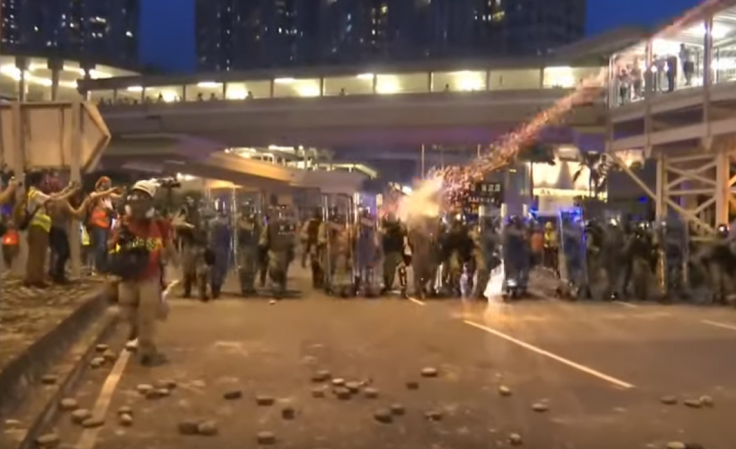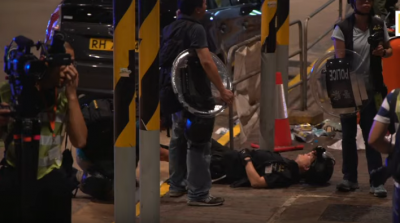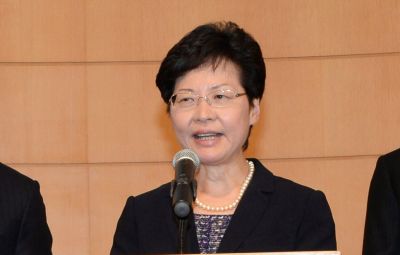
Hong Kong police fired water cannon, rubber bullets and tear gas at petrol bomb-throwing protesters on Sunday in some of the most widespread and violent clashes in more than three months of anti-government unrest.
Running battles in the Causeway Bay shopping district, Wan Chai bar area and the Admiralty district of central government offices followed a night of showdowns with police in the Chinese-ruled city, where street fires burned as the sun set.
More protests are planned in the run-up to China's Oct. 1 National Day, marking the 70th anniversary of the founding of the People's Republic.
Police fired tear gas from the roof of the Legislative Council building, which activists ransacked in early July.
Protesters, many of them dressed in black and wearing face masks, took cover from the tear gas behind umbrellas, some throwing the canisters back at police.
They built barricades with trolleys and trash cans and other debris. One threw a petrol bomb at police in the Wan Chai metro station. Others tried and failed to smash cameras over Bank of China ATMs but spray-painted the screens instead.
At least one petrol bomb landed in the grounds of central government offices where several windows were smashed. There were also street fires on the main drag of Hennessy Road.
'WE HAVE TOLERATED ENOUGH'
Protesters also smashed the windows of a taxi and sprayed graffiti on the windows of businesses including Starbucks outlets. Small scuffles continued into the evening.
Police, who raise placards warning of retaliation before firing tear gas or firing water cannon in a tradition dating back to British rule, made several arrests, often after grappling people to the tarmac.
There were no immediate reports of serious injuries.
The water cannon fired blue dye, which elsewhere in the world is used to make identification of offenders easier.
Ho, a 25-year-old working at an investment bank, was scattering bricks along a road in Wan Chai for others to use.
"When the police come, we have to move quickly and we need to pick these up as we run," he said.
Asked how he knew when the police were coming, he said supporters were following police all day, trying to listen in on their plans.
The government said that the city's leader, Carrie Lam, will be out of town for China's National Day despite her having sent invitations for celebrations at home.


Some shops closed ahead of expected demonstrations, while the MTR metro service shut stations in a move that has made it a target of violence in the past. Protesters hurled petrol bombs into a station and set fires, MTR said in a statement.
One group entered the rear driving cabin of a train and opened the emergency exit ramp to place a fire extinguisher on the track, causing a temporary suspension of services, it said.
Protesters shouted anti-China slogans and called for the government to meet their "five demands, not one less", including universal suffrage and the dropping of all charges against their arrested colleagues.
Elsewhere in the city, around midday, about 200 China supporters dressed in red T-shirts gathered on top of Victoria Peak, overlooking the harbour. They sang the Chinese national anthem and chanted "I love China".
Angela, a housewife in her forties with a Chinese flag sticker on her cheek, described the pro-democracy protesters as "thugs".
"If the government takes violent action, I don't object," she said. "We have tolerated enough. I think I have emotional problems because of the riots. Because it's not safe to go out."
CHANGE OF HEART
Lam, the focus of weeks of anti-government unrest, will leave for Beijing on Monday to celebrate the 70th anniversary of the founding of the People's Republic the following day.
Trapped in an indoor stadium by street protests for hours this week after an "open dialogue" with the people, Lam will return overland to Hong Kong on Tuesday night, minimising the chances of a clash at the airport, a popular target for protesters.
She had sent out invitations "requesting the pleasure of your company" at a flag-raising ceremony and National Day reception at the Convention and Exhibition Centre in Wan Chai on Tuesday.
It was not immediately clear why she had the change of heart, but the government said that the chief secretary for administration, Matthew Cheung Kin-chung, would stand in.
Arthur, 40, wearing glasses and a mask covering the lower half of his face, said Lam's trip was expected.
"In these three months, Carrie Lam has not really cared about the protesters. She only cares about the CCP (Chinese Communist Party) or what we might call 'her boss'," he said.
"I think Hong Kong is somehow at this moment the front line between Western democracy and the dictatorship in China ... Hong Kong looks more and more like a police state."
Police fired tear gas and water cannon on Saturday night to disperse protesters who threw petrol bombs and rocks, broke government office windows and blocked a key road near the local headquarters of China's People's Liberation Army.
The protesters are angry about what they see as creeping Chinese interference in Hong Kong, which Britain returned to China in 1997 under a "one country, two systems" formula guaranteeing freedoms that are not enjoyed on the mainland.
China dismisses the accusation and has accused foreign governments, including the United States and Britain, of fanning anti-China sentiment.
Protests were sparked in June by planned legislation that would have allowed the extradition of suspected criminals to mainland China. The bill was later withdrawn, but the protests have since expanded into a broader pro-democracy movement.
(Reuters)









